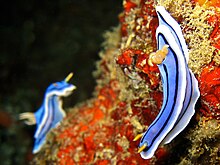
Back Nudibranchia AF عاريات الخيشوم Arabic عاريات الخيشوم ARZ Nudibranchia AZ نودیبرانچیا AZB Голохрили охлюви Bulgarian Nudibranquis Catalan Nudibranchia CEB Nahožábří Czech Nøgensnegle Danish
| Nudibranch | |
|---|---|

| |
| Berghia coerulescens | |

| |
| Chromodoris lochi pair in Puerto Galera, the Philippines | |
| Scientific classification | |
| Domain: | Eukaryota |
| Kingdom: | Animalia |
| Phylum: | Mollusca |
| Class: | Gastropoda |
| Subclass: | Heterobranchia |
| Infraclass: | Euthyneura |
| Subterclass: | Ringipleura |
| Superorder: | Nudipleura |
| Order: | Nudibranchia Cuvier, 1817 |
| Clades | |
| Diversity[1] | |
| About 3000 species | |
Nudibranchs (/ˈnjuːdɪbræŋk/[2]) belong to the order Nudibranchia, a group of soft-bodied marine gastropod molluscs that shed their shells after their larval stage.[3] They are noted for their often extraordinary colours and striking forms, and they have been given colourful nicknames to match, such as "clown", "marigold", "splendid", "dancer", "dragon", and[4] "sea rabbit".[5] Currently, about 3,000 valid species of nudibranchs are known.[6]
The word nudibranch comes from the Latin nudus 'naked' and the Ancient Greek βράγχια (bránkhia) 'gills'.
Nudibranchs are often casually called sea slugs, as they are a family of opisthobranchs (sea slugs), within the phylum Mollusca (molluscs), but many sea slugs belong to several taxonomic groups that are not closely related to nudibranchs. A number of these other sea slugs, such as the photosynthetic Sacoglossa and the colourful Aglajidae, are often confused with nudibranchs.
- ^ Wägele, H.; Klussmann-Kolb, A. (2005). "Opisthobranchia (Mollusca, Gastropoda) more than just slimy slugs. Shell reduction and its implications on defence and foraging". Frontiers in Zoology. 2 (1): 1–18. doi:10.1186/1742-9994-2-3. PMC 554092. PMID 15715915.
- ^ Longman Pronunciation Dictionary (2nd edition), ISBN 0-582-36467-1
- ^ Thompson, T. E. (2009). "Feeding in nudibranch larvae" (PDF). Journal of the Marine Biological Association of the United Kingdom. 38 (2): 239–248. doi:10.1017/S0025315400006044. S2CID 86275359.
- ^ Turnbull, John (Spring 2016). "The Nudibranch – Creature Feature". Nature New South Wales. 60 (3): 16–17.
- ^ Bronson, Wilfrid (1935). Water People.
- ^ Ocean Portal (2017). A Collage of Nudibranch Colors. Smithsonian National Museum of Natural History. Retrieved 17 April 2018.